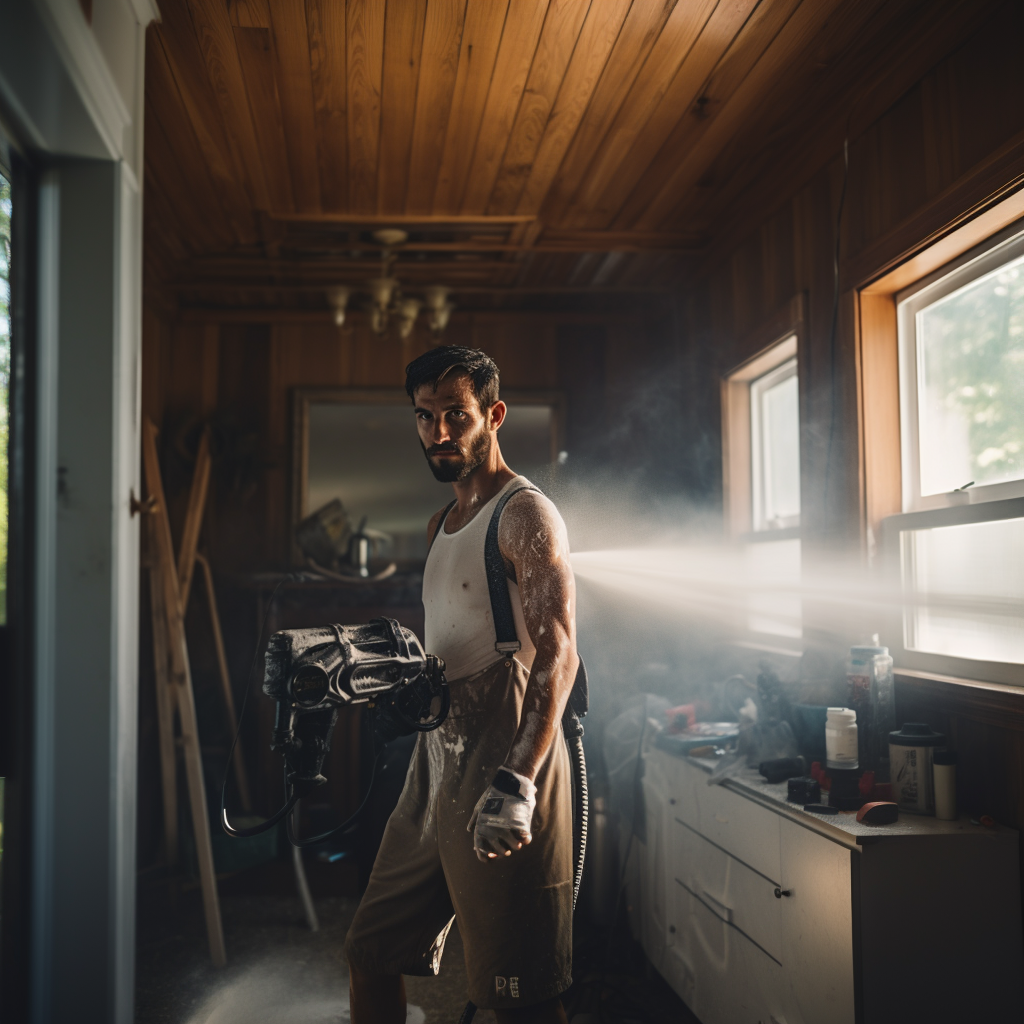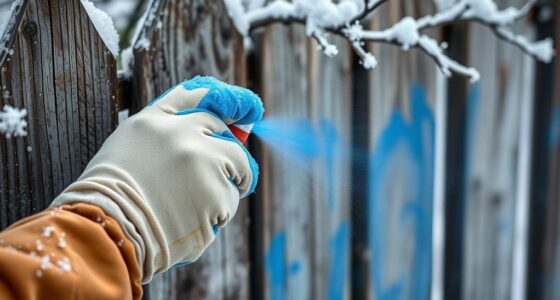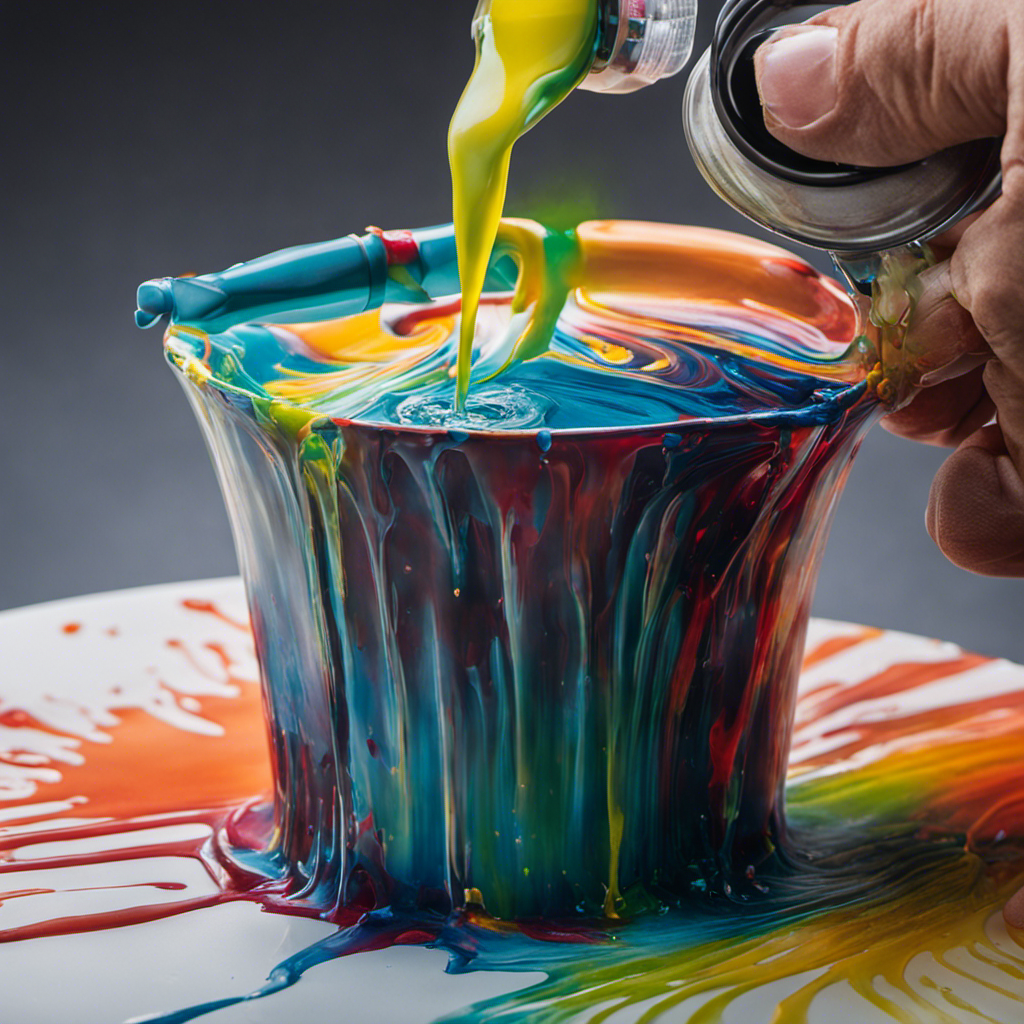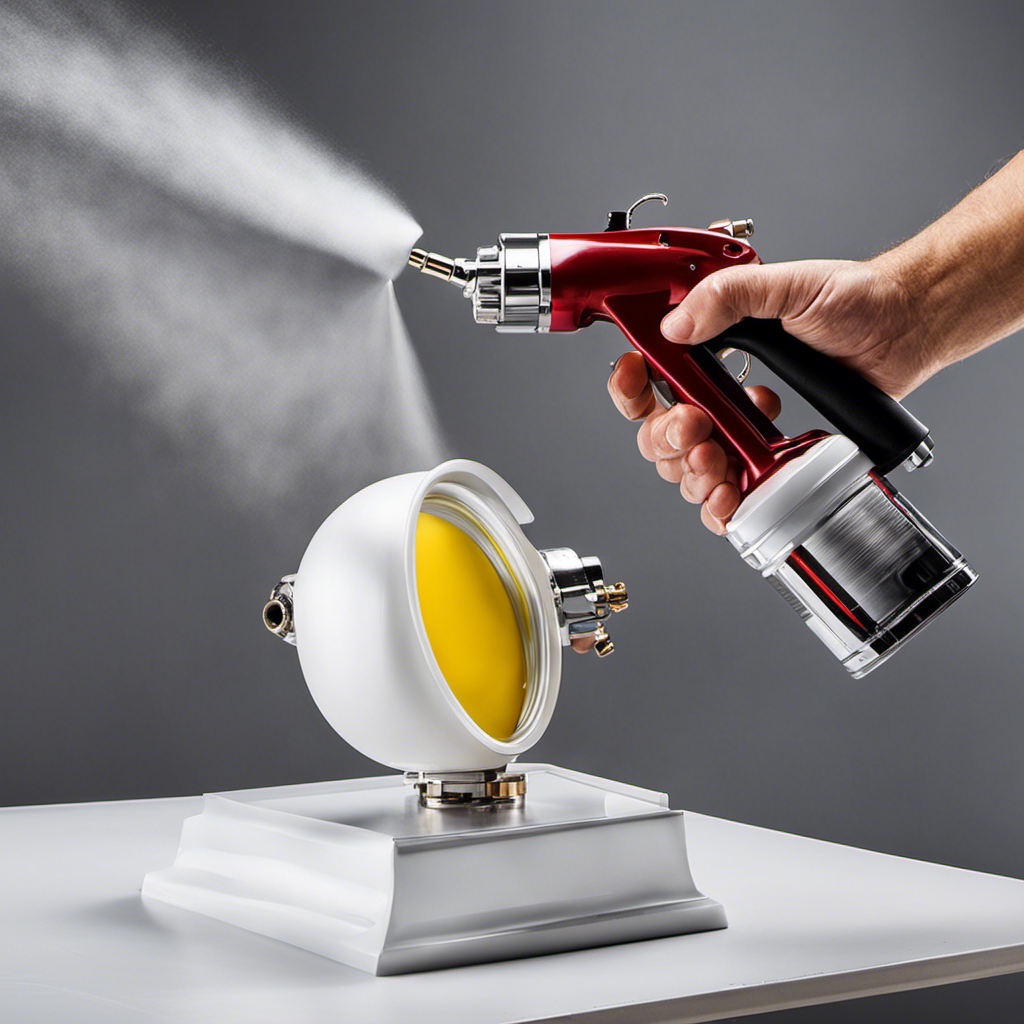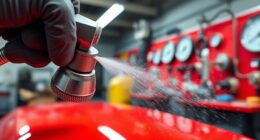To spray paint exterior walls and siding like a pro, start by preparing your workspace—clear obstacles, cover plants, and assure good ventilation. Clean and repair surfaces, then choose quality sprayers, brushes, and the right nozzle sizes. Apply primer evenly and maintain consistent distance and speed during spraying. Watch the weather: ideal conditions are between 50°F and 85°F, without high humidity or wind. Always wear safety gear and clean your tools thoroughly afterward; you’ll find tips that help achieve a flawless finish if you keep going.
Key Takeaways
- Prepare surfaces thoroughly by cleaning, repairing, and priming for smooth, durable paint application.
- Use high-quality sprayers with correct nozzles and maintain consistent distance and speed during spraying.
- Choose calm, dry weather conditions between 50°F and 85°F to ensure optimal adhesion and finish.
- Protect surrounding areas and yourself with drop cloths, protective gear, and proper ventilation.
- Clean and maintain equipment after use to ensure professional results and prolong tool lifespan.
Preparing Your Workspace and Surface
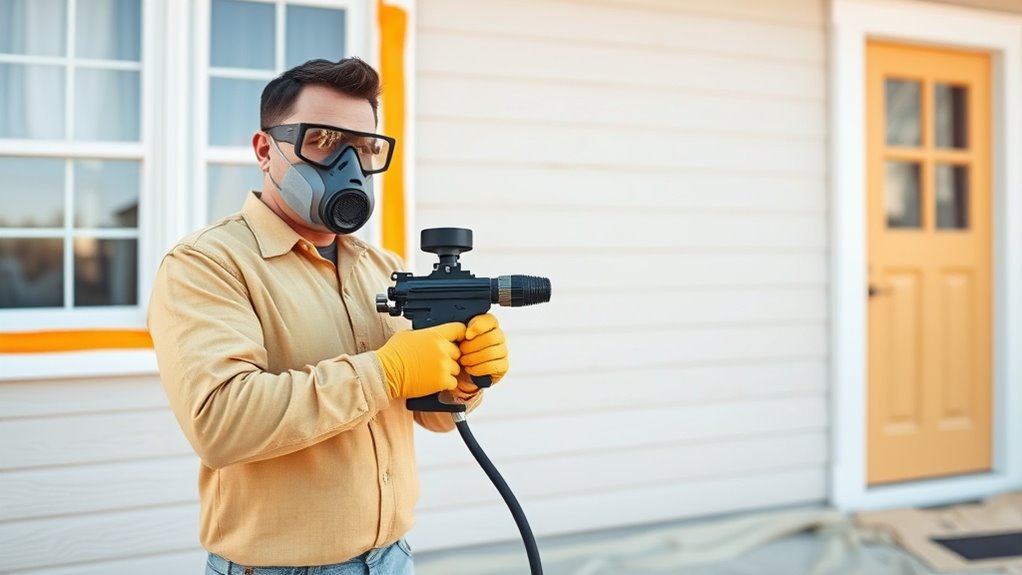
Before you start spray painting your exterior walls, proper preparation of your workspace and surface is vital. Begin by organizing your workspace to guarantee safety and efficiency. Clear the area of obstacles, cover nearby plants, windows, and fixtures with drop cloths, and set up your supplies within easy reach. Surface preparation is equally important; inspect your walls for dirt, peeling paint, or mold. Clean the surface thoroughly using a pressure washer or scrub brush with detergent. Repair any cracks or holes with filler and sand smooth for a uniform finish. A well-organized workspace minimizes accidents and interruptions, while a properly prepared surface assures better paint adhesion and a more professional look. Additionally, incorporating ergonomic workspace design can help reduce fatigue during long painting sessions, ensuring you work comfortably and efficiently. Being mindful of environmental conditions such as wind and humidity can also impact the quality of your paint job. Understanding weather impact on paint can help you plan your project for optimal results. Proper surface preparation, including surface cleaning, is essential to achieve a smooth, long-lasting finish. Incorporating proper surface maintenance practices can also extend the longevity of your paint job. Taking these steps sets a solid foundation for a successful spray painting project.
Choosing the Right Tools and Materials
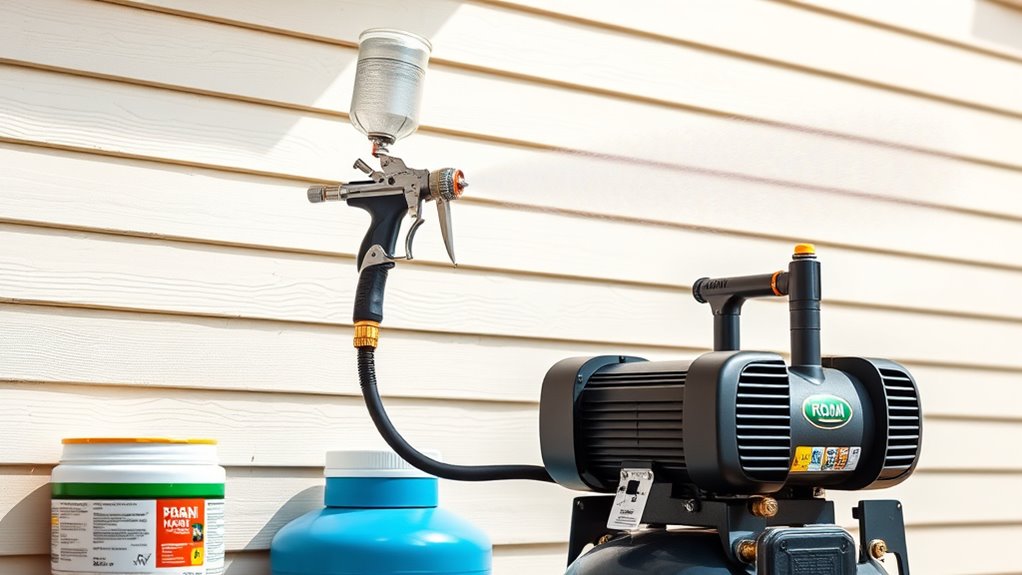
Selecting the right tools and materials is essential to achieving a clean, professional spray paint finish on your exterior walls. Choose high-quality sprayers suited for large surfaces to guarantee even spray patterns. Invest in brushes for detail work or touch-ups, mastering brush techniques for sharp edges. For consistent results, adjust your spray pattern—whether circular or sweeping—to avoid drips and uneven coats. Use the right nozzle size for your paint type and surface texture. Keep extra nozzles and protective gear handy. Here’s a quick reference:
| Tool/Material | Purpose |
|---|---|
| HVLP sprayer | Large, even coverage |
| Brushes | Detail work, touch-ups |
| Nozzle sizes | Control spray pattern |
| Drop cloths | Protect surrounding areas |
| Primer | Base coat for durability |
Applying Primer for a Flawless Finish
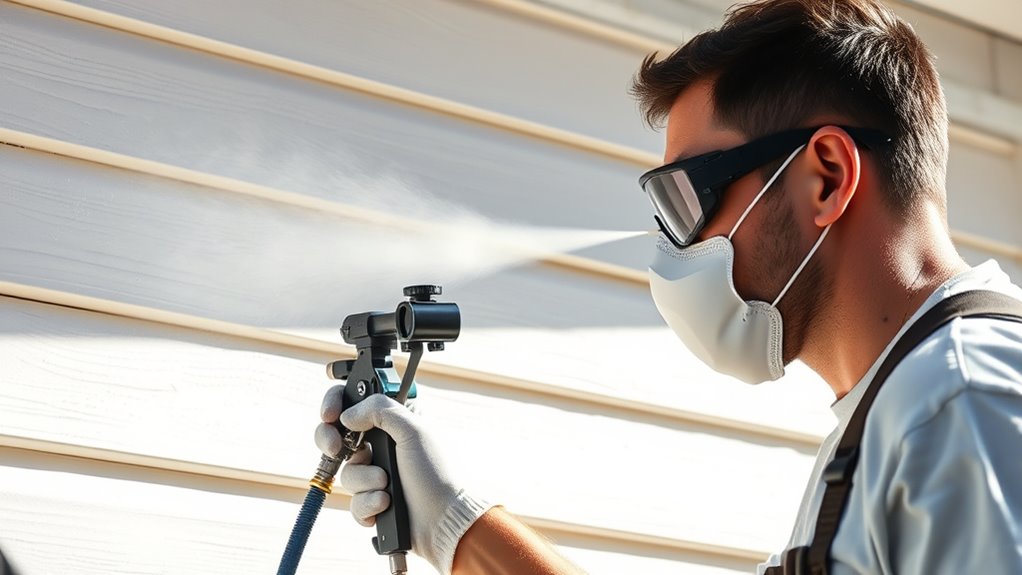
Applying primer properly sets the foundation for a smooth, long-lasting finish on your exterior walls. Before you start, guarantee thorough surface preparation by cleaning, scraping loose paint, and repairing any damage. This step is essential because it promotes better primer application and adhesion. When applying primer, use even, sweeping motions with your spray gun, maintaining a consistent distance from the wall. Avoid over-application, as too much primer can cause drips or uneven coverage. Let the primer dry completely according to the manufacturer’s instructions before moving on to painting. Proper surface preparation combined with careful primer application helps seal the surface, enhances paint adhesion, and guarantees a flawless, durable finish on your exterior walls. Knowing the local business hours of your supply store can ensure you have all necessary materials ready when you start your project. Additionally, understanding the different cookie categories used by websites can help you make informed decisions about your online privacy while researching your project. Regular maintenance and inspection of your exterior walls can also prevent issues related to weather conditions, and using the right headphone jacks can improve your overall experience when listening to music or tutorials related to home improvement projects. Incorporating powerful persuasive words into your communication can also help motivate action and ensure your project stays on track. Ultimately, these practices will extend the lifespan of your paint job.
Techniques for Even Spray Application
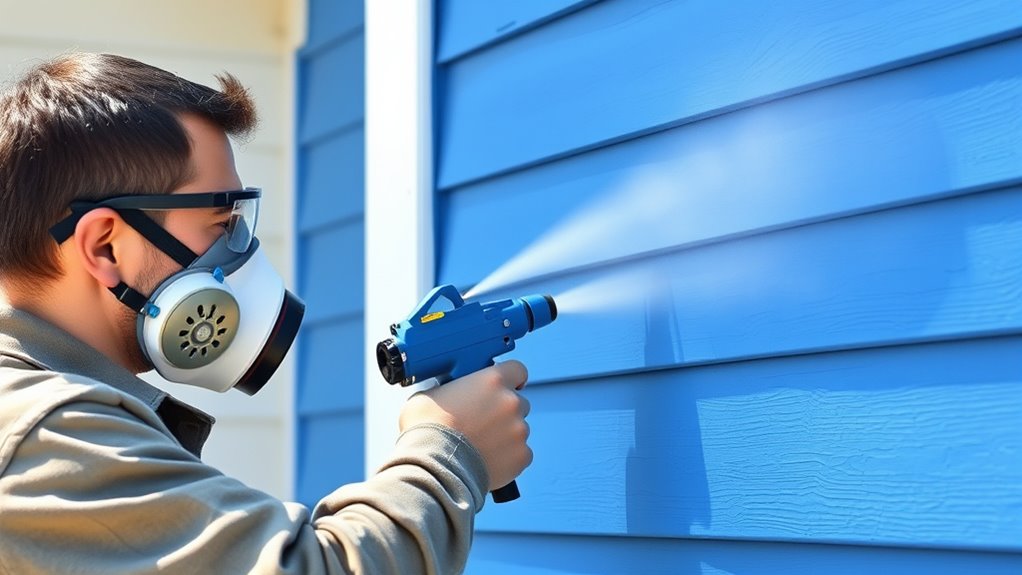
Maintaining the right spray distance helps you achieve smooth, even coverage without drips. Keeping a steady spray speed guarantees consistent application and reduces streaks. Focus on these techniques to get professional-looking results every time you paint. Additionally, adjusting the tip size appropriately ensures optimal spray pattern and finish quality for exterior walls and siding. Regularly checking pressure settings helps maintain consistent flow and prevents defects like drips or pinholes. Proper surface preparation before spraying also plays a crucial role in achieving a flawless finish.
Proper Spray Distance
To achieve a smooth, even spray when painting exterior walls, maintaining the correct distance between your spray gun and the surface is essential. Typically, this distance ranges from 8 to 12 inches, depending on your equipment and paint type. Staying consistent helps produce a uniform spray pattern, reducing drips and uneven coverage. Use your brush techniques to steady your hand, ensuring you keep the gun at a constant distance. If you get too close, paint may pool or run; too far, and coverage becomes thin or streaky. Practice maintaining this distance while moving smoothly across the surface. Proper spray distance allows the paint to atomize correctly, resulting in an even, professional-looking finish. Additionally, understanding tuning techniques can help you optimize your equipment for better spray consistency and finish quality. Applying equipment adjustments can further enhance your control and spray pattern uniformity, leading to a more professional result. Incorporating consistent technique and regular practice will also improve your overall spray application. To ensure the best results, consider evaluating your spray pattern regularly and making necessary adjustments.
Consistent Spray Speed
Keeping a steady spray speed is essential for achieving an even coat on exterior walls. When you control your spray speed, you ensure consistent spray pattern quality and avoid drips or missed spots. To maintain spray speed control, focus on smooth, even movements across the surface. This consistency helps prevent uneven coverage and enhances the overall finish. Imagine moving your spray gun in a fluid motion, maintaining constant speed and distance. Being mindful of your technique can help you develop a steady hand and accurate application. Additionally, understanding the types of honey can inspire you to choose the best natural remedies for various needs. Developing a consistent spray rhythm can further improve your application by reducing fatigue and maintaining control throughout the project. Incorporating proper equipment can also make it easier to sustain a steady pace and improve overall results. Recognizing how budgeting tips can optimize your project resources further supports a successful paint job.
Managing Weather Conditions and Timing
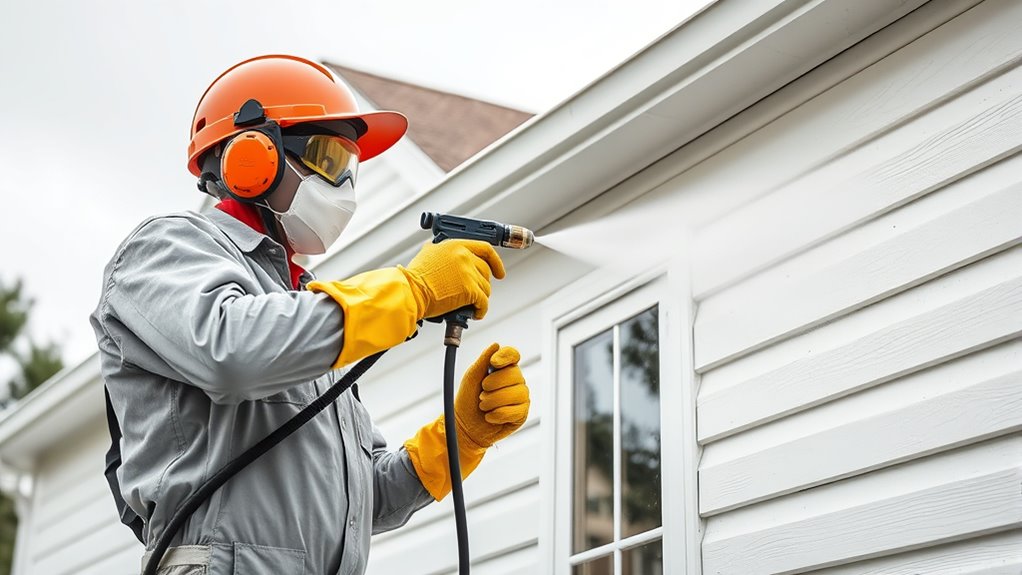
You need to choose days with a temperature between 50°F and 85°F for the best results. Painting on windy days can cause uneven coverage and overspray, so it’s best to wait for calmer conditions. By paying attention to weather, you’ll guarantee a smooth, professional finish. Additionally, monitoring security vulnerabilities can help prevent setbacks during your project, ensuring your work remains protected from unforeseen issues. Being aware of weather forecasts can help you plan your painting sessions more effectively, avoiding adverse conditions that could compromise your work. Planning your project around Grocery Savings Strategies can also help you allocate resources efficiently and avoid unnecessary delays.
Ideal Temperature Range
Choosing the right temperature is essential for achieving a smooth, durable paint job on exterior walls. The ideal temperature range is typically between 50°F and 85°F. When temperatures fall outside this window, paint may dry too quickly or too slowly, affecting the finish. Warm weather encourages proper paint mixing, ensuring consistent color selection and adhesion. Conversely, too cold can cause paint to thicken or not cure properly. Consider these factors:
- Consistent daytime temperatures
- Avoiding drastic temperature swings
- Humidity levels that don’t cause condensation
- Protecting freshly painted surfaces from dew
- Timing your project to maximize dry time
Sticking within this temperature range helps you maintain control over the paint’s consistency and finish, ensuring your project looks professional and lasts longer.
Avoid Windy Days
Windy conditions can considerably compromise the quality of your spray painting project by causing overspray, uneven application, and paint drifts. High wind reduces your spray resistance, making it difficult to control your spray pattern and maintain a smooth finish. To guarantee a professional look, avoid painting during windy days. Check the weather forecast and choose calm, still days for best results. Use the table below to compare conditions and plan accordingly:
| Condition | Effect on Spray Painting |
|---|---|
| Calm | Ideal spray resistance, even spray pattern |
| Light breeze | Slight disturbance, may need extra caution |
| Windy | Major spray drift, uneven coat, poor finish |
| Gusts | Unpredictable, difficult to control spray pattern |
| Rain | No painting, surfaces need dry conditions |
Prioritize weather to achieve a flawless exterior paint job.
Safety Precautions and Protective Gear
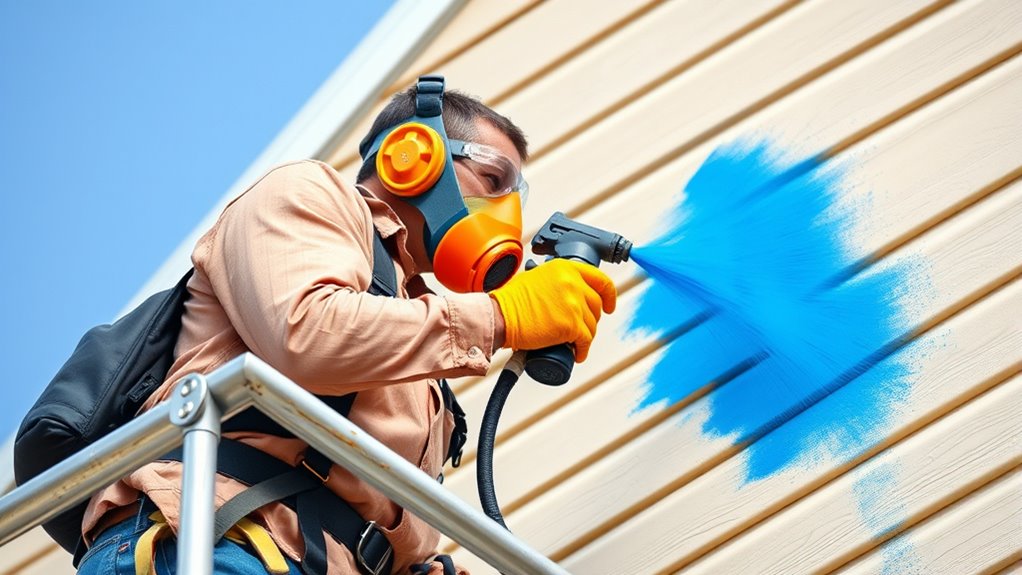
To make certain safety while spray painting exterior walls, it’s crucial to wear the right protective gear and follow proper precautions. Always don a respirator mask to protect your lungs from fumes, and wear safety goggles to shield your eyes. Use gloves to prevent paint from contacting your skin, and wear long-sleeved clothing for added coverage. Ensure proper ventilation considerations by working in open outdoor spaces or using fans to disperse fumes. Keep a dust mask handy if working in less ventilated areas. Remember, safety gear isn’t just about protection; it helps you work more efficiently and confidently. Prioritize your safety first, and your painting project will turn out great without unnecessary risks.
Cleaning Up and Maintaining Your Equipment
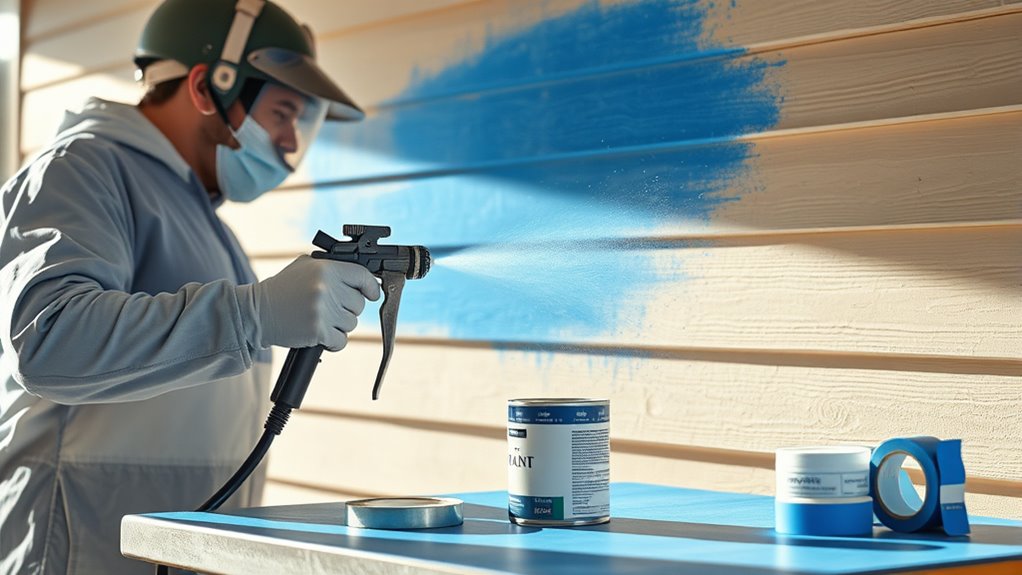
After finishing your spray painting project, it’s vital to clean and maintain your equipment promptly to guarantee it stays in good condition and performs well for future use. Rinse brushes, spray tips, and hoses thoroughly with water or the appropriate solvent to remove residual paint. Proper equipment storage is essential; store everything in a dry, clean area to prevent damage and corrosion. Be mindful of paint disposal—never pour leftover paint down drains or onto the ground. Follow local regulations for disposal or recycling to protect the environment. Regular maintenance also includes inspecting your equipment for wear and tear, replacing worn parts as needed. Keeping your tools clean and well-maintained ensures they last longer and deliver professional results every time.
Frequently Asked Questions
How Long Should I Wait Before Applying a Second Coat?
You should wait until the first coat of paint is dry to the touch, usually about 4 to 6 hours, but check the paint’s specific drying time on the label. It’s also important to take into account the curing process, which can take up to 24 hours. Rushing into a second coat too early can affect adhesion and finish, so be patient and ensure proper drying before applying the next layer.
Can I Spray Paint Over Existing Paint or Finish?
Think of your surface as a canvas waiting for a masterpiece. Yes, you can spray paint over existing paint or finish, but surface preparation is key. Guarantee proper paint adhesion by cleaning and lightly sanding the area first. Removing peeling or loose paint prevents future issues. With good prep, the new coat will stick well, giving you a smooth, professional finish that lasts longer and looks flawless.
What Are the Best Storage Methods for Spray Paint Cans?
When thinking about spray paint storage, you want to keep your cans in a cool, dry place away from direct sunlight. Use can storage containers to organize and protect them from damage. Proper spray paint storage prevents leaks, extends the paint’s shelf life, and keeps your workspace tidy. Always make sure the lids are tightly sealed, and store cans upright to avoid spills and guarantee safety.
How Do I Prevent Paint Drips and Runs?
Did you know that improper spray technique causes 75% of paint drips? To prevent drips and runs, start with a clean, well-maintained paint nozzle. Keep your spray technique consistent by maintaining a steady distance from the surface—about 10-12 inches—and move your arm smoothly. Overlapping each pass helps distribute paint evenly, reducing the chance of excess buildup that causes drips. Practice on a scrap surface before starting your project to perfect your method.
Is It Necessary to Sand or Scrape Old Paint Before Spraying?
You should definitely sand or scrape old paint before spraying to guarantee proper surface preparation. This step removes loose or peeling paint, creating a smooth surface that promotes better paint adhesion. Skipping this process can lead to uneven coverage and peeling later on. By preparing the surface thoroughly, you ensure the new paint sticks well and lasts longer, giving your exterior walls a professional, long-lasting finish.
Conclusion
Now that you know the secrets to stunning spray-painted exteriors, you’re all set to create a flawless finish. Remember, preparation and patience pave the path to perfection, so stay safe, stay steady, and spray smart. With the right tools, techniques, and timing, you’ll transform tired walls into terrific works of art. Embrace the process, enjoy the journey, and watch your outdoor space shine with professional polish and personality!
Franz came aboard the Paint Sprayer Zone team with a background in both journalism and home renovation. His articulate writing style, combined with a passion for DIY projects, makes him an invaluable asset. Franz has a knack for breaking down technical jargon into easy-to-understand content, ensuring that even the most novice of readers can grasp the complexities of paint sprayers.


